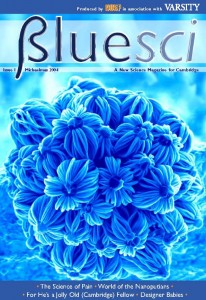SATURDAY, 29 JANUARY 2011
Success seems to be measured in tens. 20 issues, 800 years, 1000 signatures—all milestones, all arbitrary. So at moments like these, when commemoration is long due yet trivially assigned, how does one measure achievement? It’s here, in my sentimentality, that I take a cue from Frank Capra and say that success is defined by community. And community, if anything, is what BlueSci has built. Starting in 2004 as a small extra-curricular project amongst a handful of friends, the publication has blossomed into a Cambridge institution. In the two years I’ve spent with the magazine, every issue has surpassed previous records in contributions, volunteers and submissions. I’ve seen our traditional venues replaced as meeting numbers grew well beyond fire safety limits. From graphic design to Nature, from national newspapers to high profile scientific awareness campaigns, BlueSci alumni are building their presence in public science. And, in recent years, BlueSci has inspired sister publications at other universities in the UK. If community is our metric, then commemoration is certainly due.Such surging interest in science writing is a positive in a year marked by negatives in the UK. Fuelled by debt, politicians have questioned the ‘use’ of certain sciences, trying to place an immediate value on a pursuit that is defined by longitudinal assessment and initial underappreciation (e.g. Tim Berners-Lee’s “vague but exciting” proposal for the World Wide Web, which certainly would not have wooed many policy-makers, or Max Born winning the Nobel Prize in physics for a footnote). Assessing value in science, though necessary, is complex. Sometimes this doesn’t translate.
It’s the role of this and other organisations to translate. It’s perhaps fitting, then, that we’ve considered many ‘big’ ideas in the 20th issue. What’s the possible future of space exploration? What do we actually know about life in the uni verse? How is art and technology interacting with the foundations of our minds and brains? These are some of the many questions we address in small part.
Built on the backs of extraordinary volunteers, BlueSci is a sample of the best science writing from across Cambridge, one of the richest scientific environments in the world. It stands to inspire an understanding of science, create an awareness of its importance within culture, and, most of all, to enlighten. If we’ve captured a mere shimmer of the wonder, imagination and artistry of the scientific pursuit, then we’ve done our job. Taylor Burns
Issue 20: Lent 2011
Editor: Taylor Burns
Managing Editor: Stephanie Glaser
Second Editors: Amy Beeken, Robert Jones, Jonathan Lam, Luke Maishman, Kirsten Purcell, Ilia Rushkin, Sandra Schneider, Nicola Stead, Raliza Styanova, Vivek Thacker
News Editor: Imogen Ogilvie
News Team: Robert Jones, Ayesha Sengupta, Katy Wei
Book Reviews: Catherine Moir, Anders Aufderhorst-Roberts, Nicola Stead
Focus Editor: Wing Ying Chow and Natalie Lawrence
Focus Team: Yvonne Collins, Letizia Diamante, Amelia Penny
Weird and Wonderful Editor: Nicola SteadWeird and Wonderful Team: Thomas Gizbert, Tim Middleton, Helen Parker
Pictures Editor: Wendy Mak Pictures Team: Wing Ying Chow, Yvonne Collins, Ameila Penny, Jessica Robinson, Paul Simpson
Production Team: Wing Ying Chow, Alex Hyatt, Tim Middleton, Kirsten Purcell, Sandra Schneider Cartoonist: Alex Hahn Cover Image: Tim Middleton


